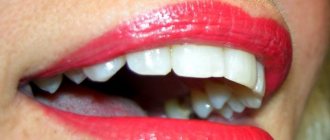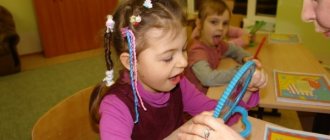The impact of sound pronunciation disorders on a person’s life is quite large. An inferiority complex often occurs, which is especially pronounced in adolescents. If a person cannot overcome it by adolescence, then there is a high probability of developing mental disorders, complexes, embarrassment of oneself and the inability to express one’s own individuality to the desired extent. Many people manage to overcome the barrier and accept their difference from others. But not every adult is able to feel comfortable communicating with other people due to existing speech disorders. And, if speech defects were not corrected in childhood, they can be eliminated in adulthood.
Lambdacism
Speech therapists call the inability to pronounce the sounds “L” and “L” correctly the term lambdacism. This means that the sound is not only mispronounced, but is also missed. This could be a congenital speech defect or simply incorrect pronunciation. Lambdacism, in turn, is divided into several types:
- Bilabial. In this version, the child replaces “l” with the sound “u”. For example, he says “horse” instead of “horse”. The lips are involved in pronunciation, the tip of the tongue is lowered, resting at the bottom of the oral cavity.
- Nasal. In this case, instead of “l”, “ng” is pronounced. For example, instead of “forest” you get “nges”. The root of the tongue touches the soft palate, and air is directed into the nose, which helps replace sound.
- Interdental. During pronunciation, the tip of the tongue goes into the space between the teeth.
- No sound is produced at all. For example, instead of “spoon,” “ozhka” comes out.
Paralambdacism
This term refers to the replacement of the correct “l” sound with another. For example:
- “g” – pronounced “kogeno” instead of “knee”
- “v” – pronounced “stov” instead of “table”
- “e” – pronounced “yokot” instead of “elbow”
- “l” – pronounced “lyozhka” instead of “spoon”
All these flaws in pronunciation can be treated by regularly doing exercises with a speech therapist and at home. Specialists are often expensive, but there are cases when just one lesson with a doctor on speech production gives a positive result, and consolidation can already be done at home.
Reasons for incorrect pronunciation of “L”
There are no unexplained causes of speech impediment. Doctors identify only three main conditions under which children cannot pronounce “l” correctly:
1. In speech, the child does not perceive “L” phonemically.
Phonemic hearing is what allows a person to distinguish one speech sound from another, hear words correctly and understand them well. Doctors recommend developing this hearing in babies from birth. That is, you need to talk to children without distorting words, so that they hear what will later be used in everyday speech. It must be remembered that written language is also formed on the basis of oral speech. Phonetic awareness thus influences future reading and writing skills. Normally, by the age of 4, a child should confidently distinguish one sound from another and not confuse “night” with “daughter” and “bear” with “mouse.”
2. The second reason for the incorrect pronunciation of “l” is the short hypoglossal ligament, due to the anatomical structure.
3. The inability to say “l” can also be a consequence of weak muscle tissues of the tongue.
We should not forget that for two- to three-year-old children, errors in speech starting with “l” are considered the norm. The formation of the correct pronunciation of “L” refers to older ages - 4 and even 6 years.
1 Why a child may not pronounce the letter “L”
The main cause of such a speech problem may be adults who often come into contact with the child. Yes, in this situation everything is exactly the same as in the educational process. The baby copies the behavior of mom or dad (in this case, the manner of speech).
Do not miss
- Do not miss
Fact of the day: fitness helps you learn foreign languages
This happens especially often in bilingual families (where two or more languages are spoken). It is difficult for a child to perceive both languages, as a result he begins to mix all the sounds.
If there is nothing like this in your family, then let’s move on to the physiological reasons:
- Disorders that arise during the development of speech hearing. In other words, the child simply incorrectly perceives what he hears and, accordingly, also reproduces the sound incorrectly.
- Pathologies of the hearing aid and speech breathing;
- Changes in the structure of the articulation apparatus. In the case we are considering, this may be due to a shortened frenulum of the tongue. Moms and dads should not be scared by this formulation. We'll fix everything. Moreover, now this no longer requires such a drastic measure as an incision. A modern non-surgical technique has been developed, with the help of which the frenulum is stretched to the required size. There are special exercises for this.
Important! Under no circumstances should parents make any diagnoses for their child. Otherwise, you can only do more harm and aggravate the situation. Before you begin to correct the defect yourself, you should definitely consult with a speech therapist.
Correct articulation of "l"
When pronouncing any sound, certain organs work. The totality of their actions necessary for the speech apparatus to make a certain sound is called articulation. What organs are involved in the correct pronunciation of the sound “l”? These are lips, teeth, and tongue. All important articulatory instruments are involved. When pronouncing “l” correctly, the following happens:
- The lips occupy the position dictated by subsequent consonants and vowels
- The tip of the tongue rests on the upper incisors or their gums
- The edges of the palate, lips and the entire oral cavity are not connected to the upper incisors, so there are passages for exhaled air on the sides
- the root of the tongue rises when pronouncing the hard “L”
- the soft palate is also raised, blocking the passage into the nasal cavity
- The vocal cords should be closed and their vibration can be felt
If all these conditions are met, the correct pronunciation of the hard sound “l” is obtained. For soft, there are a number of conditions:
- It is not the root of the tongue that is raised, but the anteromedial part of its back
- There is a closure of not only the tip of the tongue with the gums, but also most of the back of the tongue with the alveoli
- Often a soft “l” is produced if the tip of the tongue is lowered and the front part of the back closes with the alveoli
Some speech defects can be corrected by imitation. That is, by teaching the child to repeat sounds, syllables and words by ear. As experts note, in the case of the “l” sound, using only this method will not work. Precisely because of the complex articulatory work of organs. You will have to work on setting them up point by point. Especially if difficulties arise due to weak muscle tissue of the tongue.
The feasibility of speech therapy classes
Some parents do not think about how to teach their child to say the letter L. They do not consider the defect to be something serious, but in adult life it will become the basis of complexes and worries.
Important! It is better to correct speech disorders in preschool age, then the process will take a little time.
Exercises to correct the pronunciation of the sound [р]
If parents do not know how to correctly teach their child to pronounce the letters L and R, then they should contact a specialist. A speech therapist will be able to correct this problem and develop the desired pronunciation.
How many lessons does it take to produce sound [l]
It is impossible to say with certainty how many lessons will be required to eliminate the defect. Sometimes sound production takes one session, in other situations it will take more than 30-40 meetings.
It all depends on the characteristics of the child, his motivation and the interest of the parents. Learning to pronounce the sound [l] is not so easy, since a preschooler gets used to a certain stereotype. Due to their age, it is still difficult for children to perceive learning activities.
How does an individual sound production lesson work [l]
The speech therapist performs sound production only after the student performs articulatory gymnastics well. The complex is performed strictly in front of a mirror. Afterwards they do breathing exercises and perform speech hearing tasks.
How does an individual lesson on sound automation work [l]
The speech therapist conducts individual lessons on automating the sound [l] only after calling an isolated pronunciation. At such lessons, the specialist develops the lexical and grammatical structure of speech, phonetic and phonemic hearing.
To do this, use different games and simulators. Modern speech therapists use computer games. Parents are required to participate in the process and carry out the specialist’s tasks at home.
Important! The duration of the lesson for preschool age is approximately 25 minutes. Physical minutes are required to switch activities.
Mistakes when trying to pronounce "l"
Among the errors when pronouncing “l” there are the most common ones. They occur in both children and adults, but it is best to correct them at a young age, when the speech apparatus is just subject to adjustment. The most popular mistakes:
- Instead of “l” it sounds “y”. For example, the word “lie down” will be pronounced “yoozhsya”. This happens because the tongue is pulled too far into the depths of the oral cavity.
- Instead of “l”, a combination of “uva” sounds is pronounced. So, “took” will turn into “took”. The lips are placed incorrectly here.
- Replacing “l” with the sound “r”. For example, “medicine” instead of “medicine”.
- Instead of “l”, a sound similar to “f” or “n” is heard. This occurs due to a sharp, forced exhalation and participation in the articulation of the cheeks or nose.
Causes of impaired sound pronunciation in adults
Most often, impaired sound pronunciation in adults is the result of speech problems that were not eliminated in childhood. As a rule, a speech disorder is accompanied by low tone and slight incoordination of the articulatory organs: tongue, lips, jaws.
Various anomalies in the structure of the speech apparatus are often noted: an incorrectly formed bite, a short hyoid ligament, an inflated or narrow palatine vault. They can be diagnosed by a dentist or orthodontist. Also, the state of speech is affected by factors such as deterioration of physical hearing and neurological problems. Speech problems can occur due to injury or severe stress.
Preliminary articulation exercises
Before moving directly to exercises for making the sound “l”, experts advise doing a series of articulation tasks, the so-called articulatory gymnastics, which precedes the approach to making the sound “l”. This is a kind of tuning of the speech apparatus to master the rebellious sound. Here we work on the movements of the lips and tongue.
To begin with, the child is told and shown the structure of the mouth: lips, upper and lower; behind them are the teeth, upper and lower; at the top - a tubercle; behind it is the hard palate, it continues with the soft palate and ends with the velum palatine, on which there is a uvula. If a child is diagnosed with lambdacism in any form, then first you need to do the following articulation exercises (perform every day in front of the mirror, counting from one to five, for five to ten minutes, twice a day):
- “Smile” - part your lips into a smile, exposing your upper and lower teeth.
- “Tube” - lips are closed and extended forward.
- “Tongue punishment” - the tongue remains on the lower lip, it is spanked, saying “Pa-pa-pa.”
- “Cleaning the upper teeth” (from the inside) - the tongue is made wide, it is moved from side to side at the upper tubercles, also known as alveoli.
- “Sail” - the tip of the tongue should be rested on the row of upper front teeth. The tongue is like a hammock that has sagged. There is no need to move the tongue, it is simply held in this position while counting. The longer you can hold on, the better.
- “The cat drinks milk” - a wide tongue licks the upper lip from top to bottom.
- “Turkey chatter” is the same as in the “cat” exercise, but the movements are fast and accompanied by the sounds “bl-bl-bl-...”.
- “Swing” - with your mouth slightly open, you need to smile widely. On the count of “1-2”, the tip of the tongue rests on the upper and then on the lower incisors (from their inner side).
- “Horse” - click the wide tip of the tongue on the palate behind the upper front incisors. The mouth is open, but the lower jaw does not move at all.
- “Fungus” - the tongue seems to be glued to the palate, the hyoid frenulum is tense.
It is recommended to carry out such gymnastics for two to four weeks. In this way, the skill is developed to fix the necessary articulatory posture, accurately make all movements and monitor the lips, tongue and the entire speech apparatus.
4 How to properly conduct classes at home
We have already noted that the best way to teach something to a child 4-5 years old and a little older is through play. Therefore, you should not persist too much and turn speech therapy at home into torment. Everything should happen as if by itself.
At the initial stages, such exercises should be performed no more than 1-2 times a day, after which they can be increased to 3-4.
Be sure to show everything by your own example. Remember that you are the most important person for your baby. Mentor, friend and assistant all rolled into one.
Don’t forget to praise and enjoy your child’s progress, and don’t scold him if something doesn’t work out for him. This way you can discourage him from wanting to study. In addition, do not be afraid to explain to your son or daughter why and why you are doing all this. The child must realize that mom and dad always act solely in his interests.
Speech therapy exercises for the sound “L”
After mastering articulatory gymnastics, you can proceed directly to producing the sound “l”. The following exercises are used:
1. Imitation method: the student is shown how to correctly articulate the sound “l”. Smile, open your mouth slightly, open your teeth so that you can place your finger between the upper and lower teeth. The wide tip of the tongue rises and presses against the tubercles, when exhaling, the air flows along the sides, the cheeks vibrate. The child pronounces “l” after the adult. The sound should be produced when the tongue is torn away from the tubercles.
2. Setting from interdental sound (this method is not used if the defect is due to interdental lambdacism). An adult tells a fairy tale “About a steamboat that learned to whistle.”
“Once upon a time, a very tiny one sailed along the sea along with large steamships. He did everything the same as adults, but no one paid attention to him. All because he did not know how to speak - to make a steamship whistle. Instead of the beautiful “L”, he made some incomprehensible and very timid sounds. One day the steamboat decided to learn how to talk and hum like a big one. He learned by saying: “U!O! Everything is wrong." Nobody answered him and there was no dial tone. The steamboat was so upset that he bit his tongue and said: “Y.” Then an amazing thing happened: a clear and clear “L” flashed over the sea. The steamboat said it. He thought, “It must have seemed like it,” and tried again. He bit his tongue again and said: “Y.” It turned out to be a beautiful “L”. And suddenly large steamships began to answer him from all sides: “L!” "L!" So all the big ships learned about the tiny steamer, and it became heard throughout the whole sea.”
After listening to this fairy tale, the child performs all the actions behind the steamboat. He, like a fairy-tale character, may not immediately, but he should get the sound “L”. After this has happened, it must be combined with vowels. It is allowed in the reverse order IL, YL, OL, etc.
3. Method for bilabial lambdacism.
The main thing in this exercise is to learn to subjugate unruly lips. Often they are to blame for poor pronunciation - they stretch out into a tube, wrap themselves up and produce the sound “v” at the output. Speech therapists associate the inability to position the lips correctly with a long period of weaning from the pacifier. The “Smile” and “Fence” exercises are recommended: the lips are specially stretched as much as possible in a smile, the front teeth are exposed and clenched. This position must be fixed and maintained for as long as possible. At first you can’t do this without the help of an adult - you need to hold your lips, parting them into a smile.
4. Setting “L” from soft “L”
At first, learning is possible by pronouncing a soft sound instead of the correct “L”. Then it should be “tidied up” by teaching the child to pronounce the syllables LO, LU, LY, LA, touching the upper lip with the end of the tongue. And gradually removing it behind the upper teeth. It is recommended to massage the muscles around the mouth and lightly spank them with your fingers.
Three exercises to relax your muscles:
- “The horse snorts” - blow hard on your lips, imitating a horse.
- “Fish” - slap your lips together, imitating a fish.
- “Tired” - blow hard on parted lips.
Exercises to improve speech hearing
To develop speech hearing, speech therapists recommend playing games with your child:
- They suggest speaking the words first quietly, then with medium force, then loudly. You can show toys and give tasks - a small toy speaks quietly, a large one speaks loudly, then vice versa.
- They read fairy tales by role, where the characters speak in different voices - quietly or loudly, in a low or high voice.
- The child is shown pictures and named them. Some names are misspelled. If the player notices a mistake, he raises his hand or claps his hands.
- An adult shows a picture and says several similar words. Among them you need to choose one correct one (bow - meadow - hatch).
- The parent or teacher names a generalizing word. Children are asked to name examples of words from the named group. They should contain the letter L (fruits - lemons, apples, trees - maple, linden, etc.).
Training must be carried out systematically. Game activities can be supplemented with musical accompaniment.
Automation of the sound "L"
To fix the sound after at least a month of work, you need to use the following methods:
- Pronounce soft syllables and words. For example: “Lyu: cradle, people, love.”
- Learn and speak simple phrases. “LE-LE-LE – leaves were lying on the ground” and others. You can compose them yourself.
- Come up with and repeat funny poems and tongue twisters starting with “L”.
- When a sound is produced in direct syllables, you need to fix it in reverse ones. OL, EUL, etc.
Be sure to control the position of your tongue in the mirror. And do not overload the texts with words with the letter “R”. The child must focus on one complex sound.
Automation of the hard “L” occurs by analogy. First, the child repeats after the adult, then does the exercises himself.
The exercises suggested above can be done independently at home. But if there is no improvement, you should definitely go to a speech therapist.









